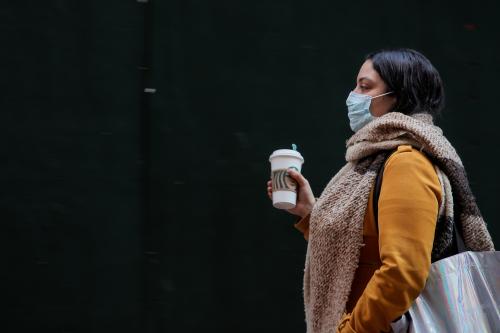A version of this op-ed was originally published in the Australian Financial Review on March 5, 2020.
World governments did not learn the right lessons from past outbreaks of disease, and we’re paying for it now as we cope with COVID-19. We have invested too little in public health and disease prevention, particularly in poor countries, given the potential economic (as well as human) costs of pandemics.
The outbreak of the coronavirus named COVID-19 in China in December 2019 is the latest in a series of diseases— SARS, bird flu, swine flu, Ebola, and HIV/AIDS—that have moved from animals into human populations. Major outbreaks of infectious diseases are not new. The 20th century saw major disease outbreaks, such as the Spanish influenza 1918-19, Asian influenza in 1957-58 and the Hong Kong influenza pandemic of 1968-69. The emergence of a pandemic is as unpredictable as that of an earthquake. Since 1970, many countries have invested in the development of national influenza preparedness plans and building global influenza surveillance and monitoring systems. The early warning systems include a network of laboratories capable of identifying the reference strain of the epidemic.
The amount of funding that countries should invest in these efforts to prepare and respond to a pandemic is an example of decision making under uncertainty. Like other national disaster planning activities, the amount of funding should be based on assumptions of the probability of catastrophic outcomes.
In the 21st century, even though scientists have warned of the inevitability of a major pandemic, the investment in public health systems has not been sufficient to reduce the probability of a major outbreak. SARS was a timely warning. Although very few people died from SARS, compared to the great pandemics of last century, the economic costs were significant. This should have prompted governments to focus on investing vastly more on improving public health systems in the poorest countries, where a range of factors increase the probability of a major disease outbreak. Despite repeated warnings, funding for many development projects, particularly in the area of public health and disease prevention, have been cut by major governments. What is needed is significant funding for medical research and far greater funding for public health in all countries, especially in the poorest countries. It is also clear that much greater focus globally should be on the practice of better hygiene in order to reduce the spread of infectious diseases. Simple, low cost, educational interventions— the virtues of hand-washing, for instance—can have a massive impact on transmission
As part of a research program in the Centre for Excellence in Population Ageing Research (CEPAR) in the Australian National University’s Crawford School of Public Policy, my colleague Roshen Fernando and I generated seven scenarios for how COVID-19 might unfold. There were two main reasons for this approach. First, it is not clear how a disease will evolve and spread. One technique to assist policymakers in planning responses under uncertainty is scenario analysis. Scenarios allow policymakers to understand potential outcomes under different assumptions which capture that uncertainty to be explored. The seven scenarios in this research were shared with policymakers globally before publication. The second goal was to demonstrate how costly a pandemic could be, and therefore how much governments should be spending to respond to the current outbreak, and how much over time they should spend to minimize the probability of a major future pandemic. We understood that in publishing this research, the results might be sensationalized, but good public policy requires transparent information based on rigorous, well-documented methods. It may well be, and hopefully will be, that the more serious scenarios we published do not eventuate. It is important though, if one of the scenarios does emerge, that governments can respond with the best policies and the populations are able to take precautions to minimize the impact.
What we did
There are many excellent studies by epidemiologists that model the likely spread of disease. We followed an alternative approach developed by economists for modelling SARS which takes the observed real-time data from China and attempts to predict what might happen to the transmission of the disease to all countries, We then used these projected epidemiological data from all countries to develop a set of economic shocks that we then put in to a global economic model, G-Cubed.
To project the transmission of COVID-19 across countries we developed a wide range of indicators of a country’s vulnerability to a pandemic. These include quality of governance, quality of public health, links to the epicentre country (China in this case), and indicators of government capacity and many others. These indicators are combined into what we call the “Index of Vulnerability.” The Index of Vulnerability is used to adjust the observed data from China on the attack rates (proportion of the entire population who become infected), case-fatality rates (proportion of those infected who die), and the implied mortality rate (proportion of total population who die). This adjustment gives assumptions about each country’s mortality rates. Countries that are more vulnerable than China will have higher rates of mortality and morbidity and countries who are less vulnerable with lower epidemiological outcomes,
Given the epidemiological assumptions for all countries, we created an additional set of filters that convert these assumptions into economic shocks for each country, such as reduced labor supply (mortality and morbidity), rising cost of doing business in each sector including disruption of production networks, consumption reduction due to shifts in consumer preferences over each good, rise in equity risk premia on companies in each sector in each country (based on exposure to the disease), as well as vulnerabilities to changing macroeconomic conditions.
We then put these shocks into a widely used global economic model, G-Cubed. This model has many countries, many sectors in each country, and many firms and households. Each region/country has a government and a central bank. The model predicts how the economy will respond.
As it is not possible to predict accurately how a virus will spread, we chose seven possible scenarios, each with a different set of assumptions. The scenarios vary by attack rate, mortality rate and the countries that experience the epidemiological shocks. These assumptions were based on previous pandemics. Scenarios 1-3 (S01, S02, S03) assume the epidemiological events are isolated to China. The economic impact on China and the spillovers to other countries are through trade, capital flows, and the impacts of changes in risk premia in global financial markets—as determined by the model. Scenarios 4-6 (S04, S05, S06) are the pandemic scenarios where the epidemiological shocks occur in all countries to differing degrees. Scenarios 1-6 assumes the shocks are temporary. Scenario 7 (S07) is a case where a mild pandemic is expected to be recurring each year for the indefinite future.
The results in the table for percent loss of GDP in 2020 demonstrate how wide-ranging the possible economic outcomes might be and how large the costs can be under these plausible scenarios. Clearly if the world was heading down a worst-case scenario, policymakers should be willing to incur much greater economic costs to minimize the impact of the pandemic. We find that the expected economic costs of the four pandemic scenarios— the ones where COVID-19 spreads outside China—far outweigh the amount that governments have been spending to minimize these outcomes. The size of the estimated economic and social costs from a pandemic should be yet another a wake-up call to governments to invest more heavily in public health systems in their own countries, but also to improve public health and economic development prospects in poor countries.
In a world that is veering towards nationalism, COVID-19 sends a clear message that global cooperation, especially on public health and reducing poverty, has potentially enormous economic and social benefits for all citizens.
GDP loss in 2020 from COVID-19 (% deviation from baseline)
| Country/Region | S01 | S02 | S03 | S04 | S05 | S06 | S07 |
| AUS | -0.3 | -0.4 | -0.7 | -2.1 | -4.6 | -7.9 | -2.0 |
| BRA | -0.3 | -0.3 | -0.5 | -2.1 | -4.7 | -8.0 | -1.9 |
| CHI | -0.4 | -1.9 | -6.0 | -1.6 | -3.6 | -6.2 | -2.2 |
| IND | -0.2 | -0.2 | -0.4 | -1.4 | -3.1 | -5.3 | -1.3 |
| EUZ | -0.2 | -0.2 | -0.4 | -2.1 | -4.8 | -8.4 | -1.9 |
| FRA | -0.2 | -0.3 | -0.3 | -2.0 | -4.6 | -8.0 | -1.5 |
| DEU | -0.2 | -0.3 | -0.5 | -2.2 | -5.0 | -8.7 | -1.7 |
| ZAF | -0.2 | -0.2 | -0.4 | -1.8 | -4.0 | -7.0 | -1.5 |
| ITA | -0.2 | -0.3 | -0.4 | -2.1 | -4.8 | -8.3 | -2.2 |
| JPN | -0.3 | -0.4 | -0.5 | -2.5 | -5.7 | -9.9 | -2.0 |
| GBR | -0.2 | -0.2 | -0.3 | -1.5 | -3.5 | -6.0 | -1.2 |
| ROW | -0.2 | -0.2 | -0.3 | -1.5 | -3.5 | -5.9 | -1.5 |
| MEX | -0.1 | -0.1 | -0.1 | -0.9 | -2.2 | -3.8 | -0.9 |
| CAN | -0.2 | -0.2 | -0.4 | -1.8 | -4.1 | -7.1 | -1.6 |
| OEC | -0.3 | -0.3 | -0.5 | -2.0 | -4.4 | -7.7 | -1.8 |
| OPC | -0.2 | -0.2 | -0.4 | -1.4 | -3.2 | -5.5 | -1.3 |
| ARG | -0.2 | -0.3 | -0.5 | -1.6 | -3.5 | -6.0 | -1.2 |
| RUS | -0.2 | -0.3 | -0.5 | -2.0 | -4.6 | -8.0 | -1.9 |
| SAU | -0.2 | -0.2 | -0.3 | -0.7 | -1.4 | -2.4 | -1.3 |
| TUR | -0.1 | -0.2 | -0.2 | -1.4 | -3.2 | -5.5 | -1.2 |
| USA | -0.1 | -0.1 | -0.2 | -2.0 | -4.8 | -8.4 | -1.5 |
| OAS | -0.1 | -0.2 | -0.4 | -1.6 | -3.6 | -6.3 | -1.5 |
| INO | -0.2 | -0.2 | -0.3 | -1.3 | -2.8 | -4.7 | -1.3 |
| KOR | -0.1 | -0.2 | -0.3 | -1.4 | -3.3 | -5.8 | -1.3 |
Source: McKibbin and Fernando (2020) “Global Macroeconomic Implications of COVID-19: Seven Scenarios,” CAMA working paper 19/2020. ANU
The Brookings Institution is committed to quality, independence, and impact.
We are supported by a diverse array of funders. In line with our values and policies, each Brookings publication represents the sole views of its author(s).







Commentary
Op-edGlobal macroeconomics of coronavirus
March 9, 2020